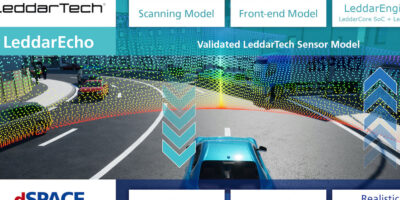Lidar simulation software emulates sensor operation in ADAS
A collaboration between LeddarTech and dSpace has resulted in the LeddarEcho lidar simulation software which runs on the latter’s Aurelion simulator.
The LeddarEcho LiDAR simulation software is for Tier-1 sensor and perception system developers. The Aurelion sensor-realistic simulator emulates the lidar sensor’s operation in a series of phases and providing a high-fidelity automotive front lidar sensor model for software-in-the-loop (SiL) and hardware-in-the-loop (HiL) applications.
Currently, sensing platform and perception system development requires the integration and calibration of the actual sensor hardware on a vehicle and the conventional data acquisition and annotation. Both are expensive and time-consuming processes. The LeddarEcho lidar simulation software provides developers with the capability to simulate different sensor concepts and combinations and validate the sensor design requirements without the need to assemble the entire system.
By providing data via the simulation models, LeddarEcho also supports the efficient development of perception systems, from sensor selection and platform architecture to data acquisition and annotation, says LeddarTech. The Aurelion sensor-realistic simulation enables sophisticated physics-based sensor models and photo realistic visualisation, says dSpace.
Benefits of LeddarEcho are claimed to be significant acceleration of the development cycle, shorter time to market and reduced development costs. It also has advantages for developing sensing and perception solutions for automotive advanced driving assistance systems (ADAS) and autonomous driving (AD) applications that use front lidars, says the company.
“The lidar front-end sensor model will enable our customers to efficiently develop, simulate, validate and optimise LeddarEngine-based lidar sensor designs using dSpace SiL and HiL testing environments,” says Christopher Wiegand, strategic product manager at dSpace. “This validation includes physically accurate simulation of the lidar and the vehicle environment, including moving objects, such as vehicles and pedestrians, as well as the road and other static objects, such as traffic signs or kerbs,” he concludes.
Additional releases planned in 2022 will include high-fidelity simulations and the modelling of various lidar components.
Visit dSpace at CES 2022 – booth #3555, LVCC West Hall.




